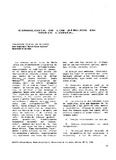| dc.rights.license | http://creativecommons.org/licenses/by-nc-sa/3.0/ve/ | es_VE |
| dc.contributor.author | Clarac de Briceño, Jacqueline | |
| dc.date.accessioned | 2023-06-14T20:16:30Z | |
| dc.date.available | 2023-06-14T20:16:30Z | |
| dc.date.issued | 2023-06-14 | |
| dc.identifier.uri | http://www.saber.ula.ve/handle/123456789/49506 | |
| dc.description.abstract | A diferencia de los dibujos de los cultos afroamericanos ( vudú especialmente) y del Dahomey, de los cuales se originan, los dibujos en el culto de Maria Lionza muestran un contenido principalmente terapéutico y ponen al paciente en "contacto directo" con las fuentes de salud, poder y amor; presentan ciertas constantes estructurales que los relacionan también con representaciones simbólicas de la tradición autóctona venezolana. | es_VE |
| dc.rights | info:eu-repo/semantics/openAccess | es_VE |
| dc.subject | simbología | es_VE |
| dc.subject | afroamericanos | es_VE |
| dc.subject | terapéutico | es_VE |
| dc.subject | autóctona | es_VE |
| dc.subject | dibujo | es_VE |
| dc.title | Simbología de los dibujos de María Lionza. | es_VE |
| dc.type | info:eu-repo/semantics/article | es_VE |
| dc.description.abstract1 | Contrary to the drawings of african cult (vodú) and those of Dahoney - from wich the former arise- the drawings of María Lionza cult exhibit an essentially "therapeutic" content and put the patient in direct contact with the health, love and power sources. They present certain structural constanst which also relate them to the symbolic representations of Venezuelan autotonous tradition. | es_VE |
| dc.description.colacion | 97-107 | es_VE |
| dc.description.email | clarack@ula.ve | es_VE |
| dc.subject.dependencia | Museo Arqueológico, "Gonzalo Rincón Gutiérrez" Universidad de los Andes, Mérida. | es_VE |
| dc.subject.keywords | Symbology | es_VE |
| dc.subject.keywords | Afro-American | es_VE |
| dc.subject.keywords | therapeutic | es_VE |
| dc.subject.keywords | autotonous | es_VE |
| dc.subject.keywords | drawings | es_VE |
| dc.subject.seccion | Boletín Antropológico: Articulo. | es_VE |
| dc.subject.tipo | Revistas | es_VE |
| dc.type.media | Texto | es_VE |


